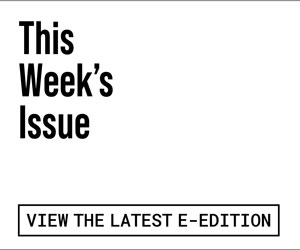 Bruce Kleinsmith’s creativity shine at Cabrillo Gallery
Bruce Kleinsmith’s creativity shine at Cabrillo Gallery
The name was too long. Kleinsmith. It took up too much space at the bottom of a drawing. He wanted something phonetic instead, something that “jumped right off the page.” A cartoon figure he liked was called Futzie Nutzle—his own cartoon. He’d done the lettering with his left hand: “an avenue into another brain hemisphere.” The Z’s jumped right off the page.
Artist Bruce Kleinsmith became Futzie Nutzle in 1967. Over the decades since, the NUTZLE signature came to signify a certain kind of drawing: crisp, decisive, often only a few lines without background on a white page. The lines describe a unique perspective on life—perhaps a view from that uncommon brain hemisphere from which Nutzle becomes Everyman and the view becomes simple, really. “It all comes back to the horizon, to earth, where we live, my feet on the ground as I’m walking,” he says. “It’s subtle humor, sense of place, source of light, weather, emotion. It’s really paradox that drives me.” Nutzle will have an exhibit of his work opening this week at the Cabrillo Gallery.
Nutzle is himself a paradox. Published throughout the world as a cartoonist, Nutzle’s work isn’t what people expect of cartoons: no caption, no punch line, no bubbles with words, never based on the news of the day and, therefore, timeless. Sometimes the pictures trigger an instant laugh, but more often a nod of recognition—recognition of a take on reality from a step removed, a take that’s exquisitely, eloquently, simply … true. The exhibition at Cabrillo Gallery shows such line drawings—projected on a screen. “Futzie Nutzle: Paintings and Works on Paper” introduces his recent oil paintings that “have to do with being at home, coming home, the importance of place, of coming and going, and an emotional quality—not anger, so many people are angry right now—more about the spirit, the path, the experience,” he says.
 Born in Cleveland, raised in a blue collar town in Ohio, Kleinsmith worked as a laborer, tried on the art life in New York then arrived in the late 1960s in Santa Cruz where he and two friends, “henry humble” and “Spinny Walker,” tried to change the face of the modern cartoon. They reported every morning to their hippie home office, a converted chicken coop across from Dominican Hospital, and drew their alternative paper, The Balloon. “We would do a drawing and then title the drawing as a piece of fine art,” he says. “We sent our paper to museums and galleries. We weren’t very mature, hadn’t developed a style, but we really had an idea that was catching fire.
Born in Cleveland, raised in a blue collar town in Ohio, Kleinsmith worked as a laborer, tried on the art life in New York then arrived in the late 1960s in Santa Cruz where he and two friends, “henry humble” and “Spinny Walker,” tried to change the face of the modern cartoon. They reported every morning to their hippie home office, a converted chicken coop across from Dominican Hospital, and drew their alternative paper, The Balloon. “We would do a drawing and then title the drawing as a piece of fine art,” he says. “We sent our paper to museums and galleries. We weren’t very mature, hadn’t developed a style, but we really had an idea that was catching fire.
“In 1976 about five or seven of us developed SCAMP—the Santa Cruz Artist Museum Project—on the top floor of a bank building on the corner of Soquel and Pacific,” he adds. “If you had the confidence to bring your art in, we tried to offer it up without opinions or critique.” The high spirits of those days included riding on Ken Kesey’s bus with Neal Cassady at the wheel along with the Merry Pranksters who often hung out in Santa Cruz. “We weren’t tearing things down, it was just really good fun,” he says.
From 1975 to 1980 Nutzle’s drawings appeared on the letters page of Rolling Stone. “Everyone then was working vertically, I began to work horizontally, because after all that’s the way we see things.” At the time, the only place for a horizontal drawing was on the letters page. “I think I started that.”
After decades in national magazines, Nutzle was hired from 1985 through the late ’90s by the Japan Times, an influential English language newspaper. Charles M. Schulz (Peanuts) was the other American cartoonist. His drawings are now exhibited in galleries and museums and collected by such bastions as the Museum of Modern Art.
The paintings at Cabrillo Gallery are both personal and universal. The low horizon of “Dads Not Coming Home” supports a tiny house from whose chimney seeps a vivid, bristling, monstrous green shape within which there is a tiny purple heart. Nutzle’s father was killed in World War II on March 18, 1945, and was awarded several purple hearts. “The shape represents an emotion so big you can’t deal with it, things going on that are too big for us,” he says. That’s what Nutzle’s art is for.
“Futzie Nutzle: Paintings & Works on Paper” opens March 18 to April 22 at Cabrillo Gallery. For more information, call 479-6308
or visit http://www.cabrillo.edu/services/artgallery/nutzle.html












Hi. My late husband, Hank Harrison, was a close friend of Bruce’s early on, although they lost touch in later years. I do remember visiting him in his studio with Hank in the 80s. Going through Hank’s collection of 60s and 70s memorabilia, I have come across a few original, line drawings, and wondered if there was a market for them these days? Sorry to have missed the exhibition last year!
Nutzle is alive and well and working in San Juan Bautista. Collectors of his work continue to be delighted at the continuing and growing relevance of his delightfully warped view of the human condition.